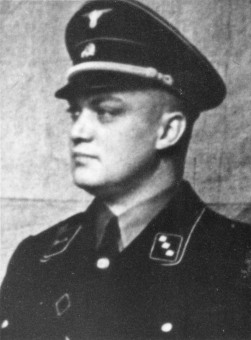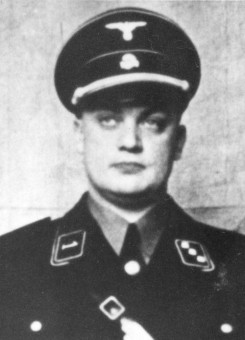Heinrich Schwarz (1906–1947)

© Fritz Bauer Institute

© Fritz Bauer Institute
Heinrich Schwarz was born in Munich on June 14, 1906. In 1919, still in his teens, he joined the Freikorps Epp, which took part in the crushing of the Bavarian Soviet Republic (Räterepublik) in Munich, serving as the civilian orderly of the Oberkommando Möhl. After completing his training as a photographer, Schwarz worked sporadically in his profession. In the period 1926–1931, he was unemployed. In late 1931, he joined the SS (No. 19,691) and the NSDAP (No. 786,871). He served in the SS-Einheit Stamm 2/I Casella and became a deputy guard commander in the security force at the “Brown House,” the party headquarters of the NSDAP in Munich.
After the transfer of power to Hitler, Schwarz was assigned to a guard detachment for the police headquarters in Munich on March 9, 1933. Under the command of Reinhard Heydrich, Schwarz was employed as of June 7, 1933, by the Bavarian Political Police to monitor the switchboard of a Munich newspaper, the MünchnerNeueste Nachrichten. In December 1933, he was working as a photographer again. On August 15, 1935, he married Amalie Gascher. Within the SS, he rose through the ranks, being promoted to SS-Unterscharführer in 1937, SS-Obersturmführer in 1939, and SS-Hauptscharführer four years later.
Schwarz began his career with the SS in the camps one week after the attack on Poland on September 1, 1939, working first in the Dachau concentration camp and next in the Mauthausen concentration camp. In June 1941, he was transferred to the SS Main Bureau for Budget and Buildings (SS-Hauptamt Haushalt und Bauten), and on September, 30, 1941, he moved to Oranienburg to the Administrative Head Office of Concentration Camps, for which he worked at Field Office I/5 (Prisoner Deployment) in Auschwitz and for a while in Birkenau. The camp commandant of Auschwitz, Rudolf Höss, utilized him as his deputy during his absence beginning in mid-August 1943. On November 10, 1943, Schwarz moved to the newly created activity known as KL (concentration camp, Konzentrationslager) Auschwitz III, and was promoted to the position of camp commandant of Auschwitz III. After the vacating of the Buna/Monowitz concentration camp in January 1945, he became camp commandant of the Natzweiler-Struthof concentration camp in Alsace on February 1, 1945. Because of the crimes he committed there, he was sentenced to death by a French military tribunal in Rastatt on February 1, 1947, and executed on March 20, 1947.
(FS; transl. KL)
















